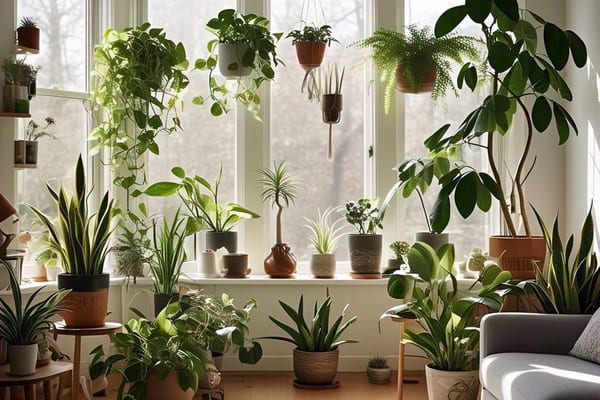If you often feel stuffy or fatigued indoors, your indoor air quality could be the culprit. Surprisingly, the air inside our homes can be two to five times more polluted than outdoor air, according to the Environmental Protection Agency (EPA). Dust, pet dander, volatile organic compounds (VOCs), and mold spores are common pollutants that can compromise your well-being. Fortunately, certain houseplants can act as natural air purifiers, removing toxins while enhancing your living space. Here are some Air-Purifying Plants you can’t miss out on:

Top 9 Air-Purifying Plants You Can’t Miss Out on:
Snake Plant (Sansevieria)
Known as the “bedroom plant”, the snake plant is exceptional at producing oxygen at night. Studies by NASA’s Clean Air Study reveal that snake plants can filter toxins such as benzene, formaldehyde, and xylene. Its ability to thrive in low light and require minimal watering makes it perfect for busy households.
Spider Plant (Chlorophytum comosum)
Spider plants are among the most effective houseplants for reducing indoor pollutants. Research highlights their ability to remove carbon monoxide, formaldehyde, and even odors. With their adaptable nature and rapid growth, spider plants are ideal for improving air quality in kitchens and living rooms.
Peace Lily (Spathiphyllum)
Peace lilies not only add elegance to your home but also efficiently remove toxins like ammonia, benzene, and formaldehyde. According to NASA’s Clean Air Study, peace lilies are particularly effective in reducing mold spores, making them ideal for bathrooms or damp spaces. Just remember to keep them out of reach of pets, as their leaves can be mildly toxic if ingested.
Aloe Vera (Aloe barbadensis miller)
Beyond its soothing gel for burns, aloe vera is a powerful air purifier. It absorbs benzene and formaldehyde commonly found in cleaning products and paint. Positioning an aloe plant on a sunny windowsill can enhance both its growth and air-purifying capabilities.

Bamboo Palm (Chamaedorea seifrizii)
If you’re seeking a low-maintenance plant that thrives in indirect light, the bamboo palm is a top contender. It excels at humidifying indoor spaces while effectively removing toxins like carbon monoxide and formaldehyde. Bamboo palms are particularly suited for bedrooms or home offices, where improved air circulation is beneficial.
Boston Fern (Nephrolepis exaltata)
Boston ferns are natural humidifiers, known for their ability to restore moisture to dry indoor air. These lush plants excel at filtering formaldehyde and xylene. Keeping a Boston fern in rooms with wood furniture or carpeting can reduce irritants and enhance comfort.
Rubber Plant (Ficus elastica)
Rubber plants are powerful toxin absorbers, especially effective in removing carbon dioxide and VOCs. Their broad, glossy leaves efficiently trap airborne particles, making them a valuable addition to living spaces or offices. Rubber plants thrive in moderate sunlight and require minimal watering.
Areca Palm (Dypsis lutescens)
Renowned for its air-purifying properties, the areca palm removes toxins such as toluene and xylene. It’s also a natural humidifier, which can help alleviate respiratory issues in dry climates. This plant flourishes in well-lit spaces, making it a stylish yet functional indoor addition.
English Ivy (Hedera helix)
English ivy is a versatile plant recognized for its ability to reduce airborne mold and fecal particles. Research indicates it can effectively minimize indoor pollutants in homes with pets. Placing English ivy in hanging baskets or shelves allows it to thrive while enhancing your home’s aesthetics.
Boosting Air Quality with Strategic Plant Placement
For optimal air-purifying benefits, consider placing plants strategically throughout your home. Bedrooms, living areas, and home offices benefit from oxygen-boosting plants like snake plants and bamboo palms. Meanwhile, peace lilies and ferns are excellent in bathrooms where moisture levels are higher. Combining various plant types can create a natural air-purifying ecosystem indoors.
Final Thoughts
Incorporating air-purifying plants into your home is a simple yet effective way to improve indoor air quality. Alongside their aesthetic appeal, these plants work silently to filter toxins, boost oxygen levels, and enhance your overall well-being. By choosing the right plants and placing them strategically, you can enjoy cleaner, fresher air every day.




